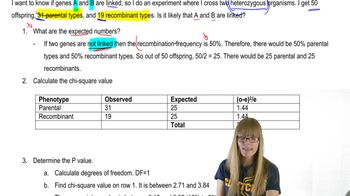How do copy-number variants arise? Do they account for more polymorphism than SNPs within the human population?
Table of contents
- 1. Introduction to Genetics51m
- 2. Mendel's Laws of Inheritance3h 37m
- 3. Extensions to Mendelian Inheritance2h 41m
- 4. Genetic Mapping and Linkage2h 28m
- 5. Genetics of Bacteria and Viruses1h 21m
- 6. Chromosomal Variation1h 48m
- 7. DNA and Chromosome Structure56m
- 8. DNA Replication1h 10m
- 9. Mitosis and Meiosis1h 34m
- 10. Transcription1h 0m
- 11. Translation58m
- 12. Gene Regulation in Prokaryotes1h 19m
- 13. Gene Regulation in Eukaryotes44m
- 14. Genetic Control of Development44m
- 15. Genomes and Genomics1h 50m
- 16. Transposable Elements47m
- 17. Mutation, Repair, and Recombination1h 6m
- 18. Molecular Genetic Tools19m
- 19. Cancer Genetics29m
- 20. Quantitative Genetics1h 26m
- 21. Population Genetics50m
- 22. Evolutionary Genetics29m
22. Evolutionary Genetics
Phylogenetic Trees
Problem D.8
Textbook Question
Describe how selection at a locus can result in a loss of polymorphism surrounding the locus.
 Verified step by step guidance
Verified step by step guidance1
Understand that selection at a locus refers to the process where certain alleles increase in frequency because they confer a fitness advantage, while others decrease or are eliminated.
Recognize that when a beneficial allele is strongly favored by selection, it can rapidly increase in frequency and eventually become fixed in the population, meaning all individuals carry that allele.
Know that loci physically close to the selected locus on the chromosome tend to be inherited together due to linkage, a phenomenon called genetic hitchhiking or selective sweep.
Realize that as the beneficial allele rises to fixation, the linked alleles at nearby loci also increase in frequency, reducing genetic variation (polymorphism) in that surrounding region.
Conclude that this reduction in polymorphism occurs because recombination has limited opportunity to separate the beneficial allele from its neighboring alleles during the rapid selective sweep, leading to a loss of diversity around the selected locus.
 Verified video answer for a similar problem:
Verified video answer for a similar problem:This video solution was recommended by our tutors as helpful for the problem above
Video duration:
1mPlay a video:
Was this helpful?
Key Concepts
Here are the essential concepts you must grasp in order to answer the question correctly.
Natural Selection and Selective Sweeps
Natural selection favors alleles that increase an organism's fitness, causing these alleles to rise in frequency. When a beneficial mutation at a locus rapidly increases in frequency, it can 'sweep' through the population, reducing genetic variation at nearby linked loci, a process known as a selective sweep.
Recommended video:
Guided course

Natural Selection
Genetic Linkage and Linkage Disequilibrium
Genetic linkage refers to the physical proximity of genes on a chromosome, which affects their likelihood of being inherited together. Linkage disequilibrium occurs when alleles at different loci are non-randomly associated, so selection at one locus can indirectly reduce variation at linked loci.
Recommended video:
Guided course

Chi Square and Linkage
Polymorphism and Genetic Variation
Polymorphism is the presence of two or more alleles at a locus within a population. Genetic variation is essential for evolution, but strong selection at one locus can reduce polymorphism nearby by favoring one allele and eliminating others, leading to a loss of diversity in that genomic region.
Recommended video:
Guided course

Genomic Variation
Related Videos
Related Practice
Textbook Question
424
views


